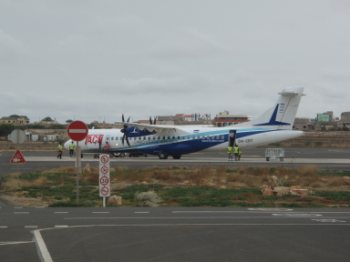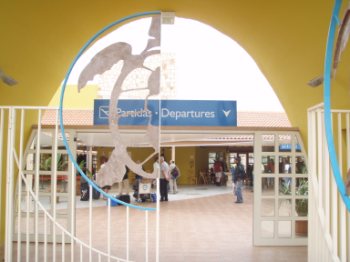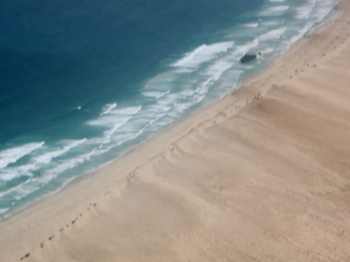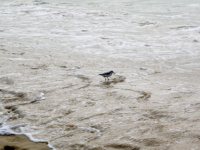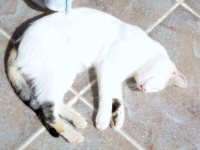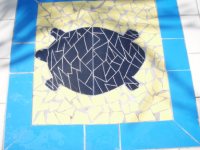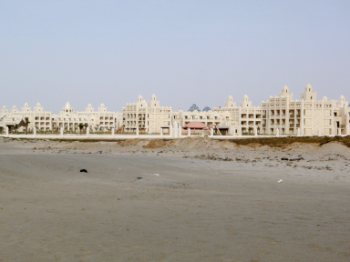Boa Vista

|
Boa Vista
Boa Vista is 50 kms to the south of Sal and is the closest of the Cape Verde islands to the coast of Africa. The first navigators named her Sao Cristovao (in honour of Christopher Columbus) - its current name - Boa Vista is because it was the first landfall that came into sight after often treacherous journeys through the reefs. The island was discovered on the 14th of May 1460 and left to oblivion for 150 years. Columbus himself shored the island in 1498 and described the difficulties he found there. 17 miles to the south of the island is the infamous reef Baixo de Joao Leitao where many shipwrecks are found. The reef Hartwell bears the name of the vessel wrecked there in 1787 is on the eastern side of the island, it is 6 kms long and in part visible and dangerous.
The little plane, islanders are justly proud of their airport, one of the shipwrecks we saw from the air. Around 1620 some English navigators, noticed the high quality of the salt found on the island and established Povoacao Velha to exploit this natural resource. The frequent attacks from pirates did not allow for regular development until 1820 when the islanders were forced to build a fortress in Porto Ingles (now Sal Rei). From then on, the island has prospered quite well and gained some cultural importance from Morna, the emblematic musical style of Cape Verde, born on the island.
The airport looks like a sandcastle, we loved this sign in arrivals and the plaque. Boa Vista is 15 minutes by air taxi from Sal International Airport and is the third largest island after Sao Antao and Santiago. The island is 31km long north to south and is 29km wide west to east and has a population of just under 5,000. This is the smallest population of all the Cape Verde islands (excluding the three that are uninhabited). Much of the island is flat with the highest point being Monte Estancia at 287m, other mountains include Santo Antonio and Monte Negro. The climate is influenced by the hot, dry winds from the Sahara and has very little rainfall. The main industries today are date farming and tourism, although road infrastructures available are not sufficient to allow the island to fully exploit its natural richness. There is one main road of tarmac, the rest are made of basalt stones laid by the island women many years ago and are now very lumpy and in need of huge investment.
A resident Gecko, a bird we videoed, a crab, one of the hotel cats we befriended and the nearest we came to a turtle. Urgent international effort is needed to conserve West Africa's Loggerhead turtles - Caretta Caretta, studies show that the region holds the world’s fourth largest feeding and nesting sites, many of them under threat. Most activity takes places on the east coast beaches at night, tourists are asked not to disturb the turtles by shining torches at them. Quad bikes are supposed to stay 80 meters back from the waters edge, sadly we saw them much closer. The International University Campus for Studies and Conservation hold field camps each year from June to October (since 1999) which is when these turtles come ashore to lay their eggs. Students from both Europe and Cape Verde participate. A rare bird nests on the islets - Rabil (Fregata Magnificens).
The ceramic factory ruins, gradually being buried by sand, just along the beach from our hotel. There is little to see on the island. Santa Antonio Chapel in Pavoacao Velha, where the first settlement was built. Saint Roque Church, the oldest built in 1801, in the village of Rabil (the ancient capital) next to the airport. The islet of Sal Rei where you can see the ruins of Duque de Braganca Fort. The lighthouses of Morro Negro and Porto do Sol offer views of the Atlantic, that is really all there is. The traditional dish of Boa Vista is Canja de Capado (goat meat soup). Botchada is made using the stomach of sheep or goat. Dried mackerel, grilled tuna steak, lobster and goat cheese dishes are very popular.
The beach outside our hotel, a dune along the beach and still further the Riu Karamboa, with 740 rooms is a vast development. Boa Vista has 55 kms of white sandy beaches, in fact it has Cape Verdes longest beach at 18 kms. Projects have been started in Boa Vista by major tour operators to develop the island into a major tourist destination, if not now, certainly in the future. Boa Vista is superb for water sports, diving, beach casting and boat fishing, wind and kite surfing. Or simply stroll down along one of the beautiful white sandy beaches or completely relax with a good book as we did. To the south of the island is Santa Monica beach, with miles of white sand, and to the west of the island is Chaves beach, with the luxury, all inclusive Italian hotel development, part of the Riu group (above) and a few other smaller hotels, we stayed in one of the smaller ones, the Parque das Dunas.
All in all a pleasant little island well known for marine turtles, traditional music, friendly people, sand dunes and beaches. |

